As an Amazon Associate KitchenwareSets.com earns from qualifying purchases.
Discover 11 Japanese Kitchen Organization Hacks For Small Spaces
Do you ever open your kitchen cabinets and feel a wave of stress? That avalanche of mismatched Tupperware, the spice jars you can never find, and countertops that have completely disappeared under clutter—it’s a familiar story for anyone with a small kitchen. It feels like a constant battle, turning what should be a creative and joyful space into a source of daily frustration. You know there has to be a better way, but the chaos feels too big to tackle.
This feeling of being overwhelmed is completely valid. A cramped, disorganized kitchen doesn’t just look bad; it makes cooking inefficient and stressful. You waste time searching for that one specific lid or utensil, and you might even give up on cooking altogether in favor of takeout. But what if you could transform that space into a sanctuary of calm and efficiency, where everything has its place and cooking becomes a pleasure again?
The solution lies in the elegant and mindful approach of Japanese kitchen organization, which focuses on maximizing every inch of space through clever, minimalist solutions. This philosophy isn’t just about tidying up; it’s about creating a serene, functional, and beautiful environment. It emphasizes using vertical storage, turning unused gaps into functional pantries, and employing multi-functional tools to create a clutter-free kitchen, no matter how small it is.
Feeling Overwhelmed by Your Small, Cluttered Kitchen?
The core reason your small kitchen might feel so overwhelming is often a lack of efficient systems for utilizing the space you have. In most Western kitchens, we focus on horizontal space—our countertops and shelves—which quickly fills up. Japanese design, born from the necessity of living in smaller homes, flips this concept on its head. It masters the art of vertical space, hidden storage, and multi-functional tools to create an environment that feels open, airy, and incredibly functional, even in the most compact, galley-style layouts.
Drawing from years of obsession with minimalist design and practical solutions for small-space living, we’ve distilled the most effective Japanese organization principles into this guide. You don’t need a massive renovation; you just need a shift in perspective and a few clever hacks. We’re about to explore 11 actionable, easy-to-implement strategies that will not only organize your kitchen but also bring a sense of peace and order to your daily routine.
The Philosophy Behind Japanese Kitchen Organization: Less is More
The secret to its effectiveness lies in a deep-rooted philosophy that values simplicity, functionality, and mindfulness. It’s not just about finding a spot for everything; it’s about intentionally choosing what to keep and how to store it to create a harmonious environment. By understanding the ‘why’ behind these methods, you can apply them more effectively and maintain an organized kitchen for the long term.
Here are the core principles:
- Danshari (断捨離): This is the art of decluttering, but it goes deeper than just tidying up. It’s a three-part concept: Dan (refuse) – stop accepting things you don’t need; sha (dispose) – get rid of clutter you already have; and ri (separate) – detach from the desire for material possessions. In the kitchen, this means letting go of the single-use gadgets and duplicate utensils you never reach for.
- Functionality First: Every item in a Japanese kitchen has a clear purpose. The design focuses on creating an efficient workflow where the tools you use most often are the most accessible. It’s about creating a kitchen that works for you, not against you.
- Valuing Empty Space: In minimalist Japanese aesthetics, empty space (or “ma”) is not seen as a void to be filled but as an essential element of design. Clear countertops and uncluttered shelves create a sense of calm and openness, making the entire room feel larger and more peaceful.
11 Japanese Kitchen Organization Hacks to Maximize Your Small Space
The true genius of Japanese kitchen design is found in its simple, high-impact storage solutions. These are not complicated DIY projects; they are clever, often inexpensive hacks designed to reclaim lost space and create a kitchen that is both beautiful and hyper-functional. Each of these hacks has been selected for its proven effectiveness in real-world small kitchens, focusing on high-impact changes that require minimal effort. Get ready to transform your kitchen from cluttered to calm with these 11 game-changing ideas inspired by Japanese ingenuity.
1. Utilize Magnetic Surfaces to Free Up Counters
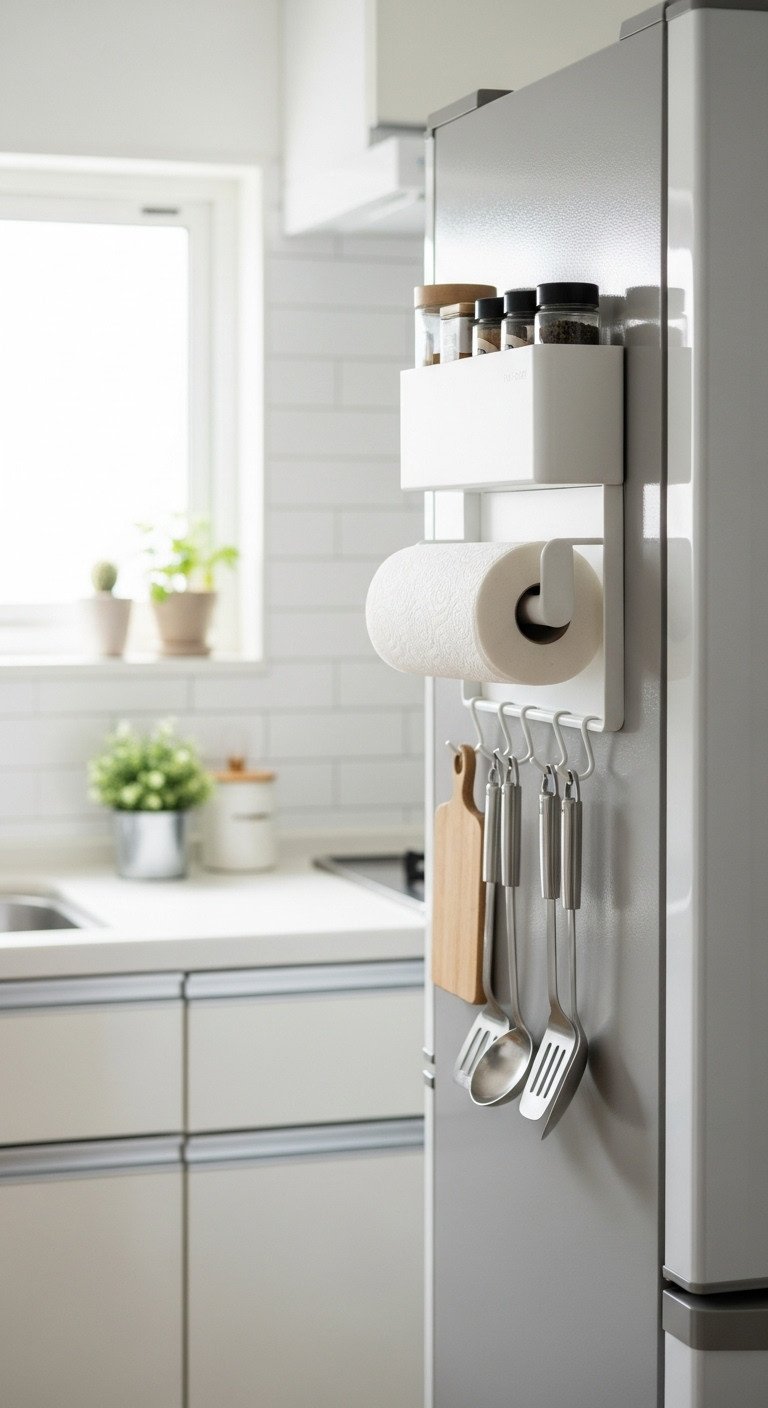
Pin this genius space-saving idea for your kitchen!
One of the best ways to instantly reclaim counter space is to leverage the massive, unused magnetic surface of your refrigerator. Instead of letting this prime real estate go to waste, you can use it to hold everyday items, keeping them off your counters but still within easy reach.
- Materials Needed: 1x high-quality magnetic organizer rack.
- Step-by-Step Directions:
- Identify the most convenient magnetic surface in your kitchen, typically the side of your refrigerator.
- Wipe the surface clean with a dry cloth to ensure a strong connection.
- Unbox your magnetic organizer. A high-quality organizer, like those from Yamazaki, will have strong magnets and require no assembly.
- Simply attach the organizer to the refrigerator. Press firmly to secure it.
- Arrange your most-used items like paper towels, spices, and cooking utensils on the rack for easy access.
Pro-Tip: Before buying, measure the depth of the space next to your fridge to ensure the rack won’t obstruct any nearby doors or walkways. A slim profile is key!
2. Hang Produce in Breathable Mesh Bags
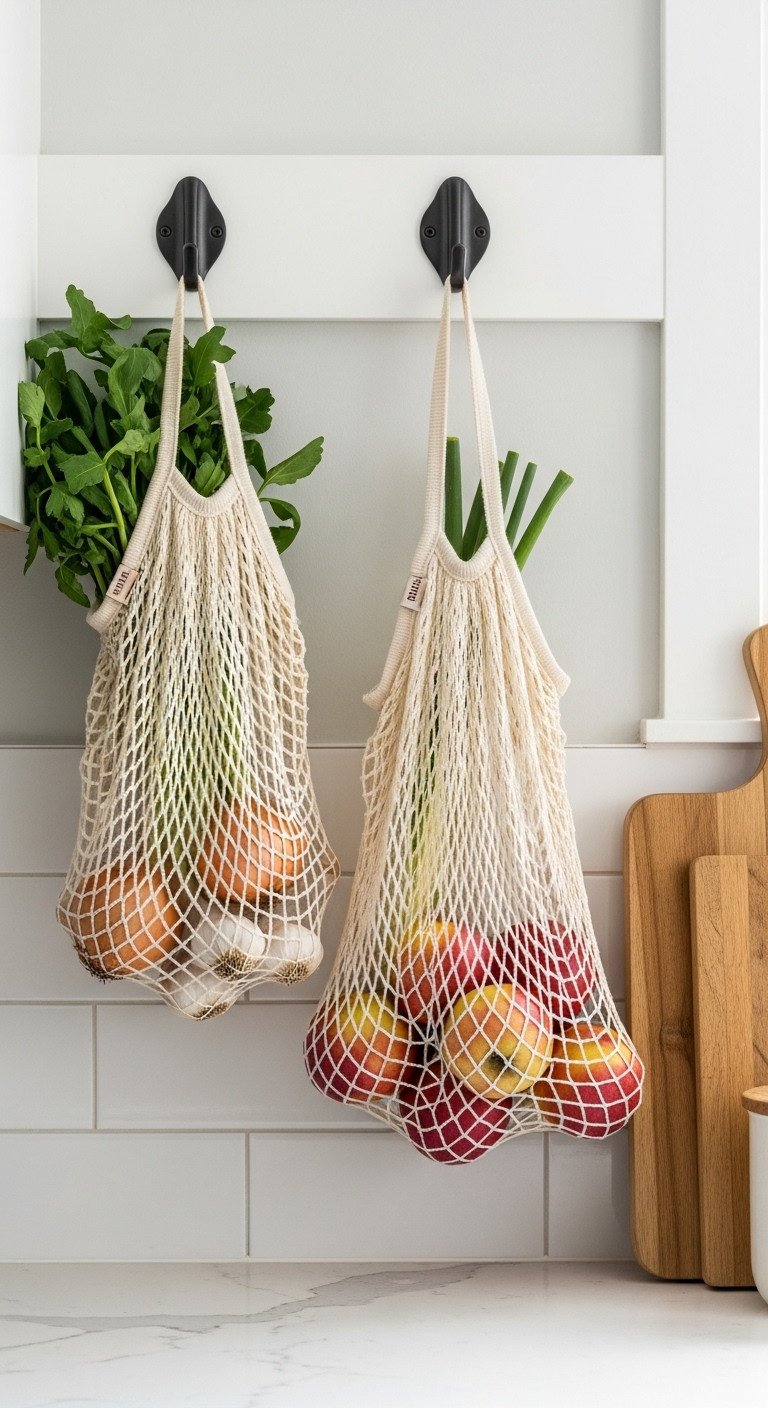
Save this eco-friendly storage idea to your ‘Kitchen Organization’ board!
A traditional fruit bowl is a classic countertop-clutter culprit. A better solution is to hang your produce in breathable mesh bags, which saves space, allows air to circulate to keep produce fresh, and adds a charming aesthetic to your kitchen.
- Materials Needed: 2-3 organic cotton mesh produce bags, 2-3 wall hooks (adhesive or screw-in).
- Step-by-Step Directions:
- Choose a clear wall space in your kitchen, preferably away from direct sunlight and heat.
- Install your hooks according to the package instructions.
- Fill your breathable mesh bags with thick-skinned produce like onions, garlic, potatoes, or apples. The mesh allows air to circulate, which helps prevent spoilage.
- Hang the bags from the hooks. This not only frees up counter space but also adds a rustic, farmer’s market aesthetic to your kitchen. These bags can also be used for grocery shopping.
Lesson Learned: Don’t store onions and potatoes in the same bag! They release gases that can cause the other to spoil faster. Hang them in separate bags.
3. Employ Inexpensive Adhesive Hooks Everywhere
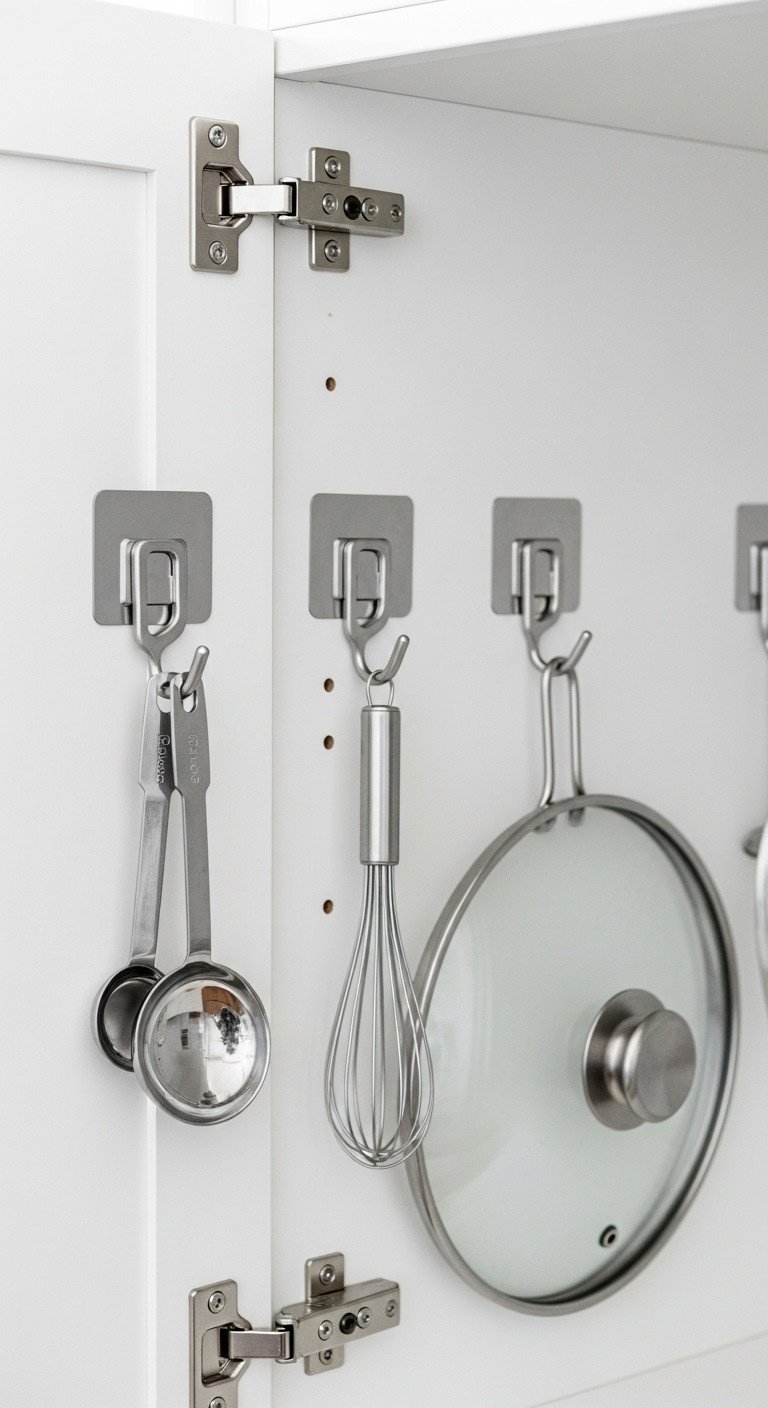
Such a simple hack! Pin it for later!
One of the most versatile and budget-friendly organization tools is the simple adhesive hook, which can turn any flat surface into valuable storage. From the inside of cabinet doors to the side of your microwave, these little hooks can hold an astonishing variety of items, freeing up precious drawer space.
- Materials Needed: A pack of high-quality, heavy-duty adhesive hooks.
- Step-by-Step Directions:
- Identify underutilized surfaces like the inside of cabinet doors, the side of a tall cabinet, or the backsplash wall.
- Clean the surface thoroughly with rubbing alcohol and let it dry completely. This is crucial for a strong bond.
- Peel the backing off a hook, press it firmly against the surface for 30-60 seconds.
- Wait at least one hour before hanging anything to allow the adhesive to fully cure.
- Hang lightweight items like spatulas, measuring cups, towels, and even pot lids to reclaim drawer and counter space. Look for hooks made of stainless steel that are waterproof and rust-proof for use near the sink.
Pro-Tip: When hanging pot lids, use two hooks per lid, spaced apart, to create a secure cradle for the lid to rest in.
4. Invest in an Over-the-Sink Dish Rack
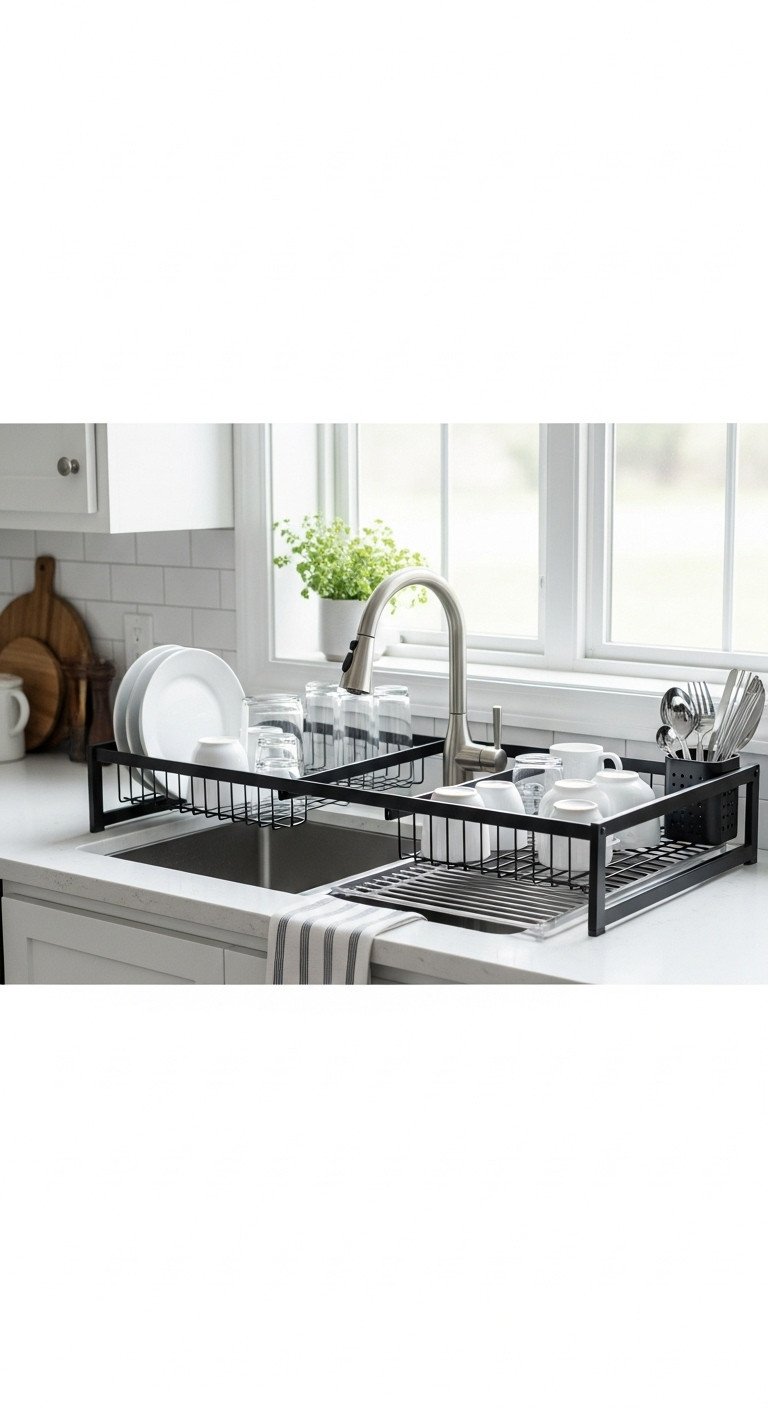
The ultimate space-saver! Add this to your ‘Dream Kitchen’ board.
For those with truly limited counter space, a bulky countertop dish drainer is out of the question. The solution is an adjustable over-the-sink dish rack that utilizes the vertical space above your sink, allowing dishes to drip-dry directly into the basin without taking up a single inch of your work surface.
- Materials Needed: 1x adjustable over-the-sink dish drying rack.
- Step-by-Step Directions:
- Measure the width of your sink before purchasing to ensure a perfect fit. Many over-the-sink racks are adjustable to accommodate various sink sizes.
- Assemble the dish rack according to the manufacturer’s instructions. Most are designed for easy, tool-free assembly.
- Position the rack over your sink. Look for models with anti-slip feet or suction cups to ensure it stays securely in place.
- Load your washed dishes, glasses, and utensils onto the rack. Water will drip directly into the sink, keeping your counters dry and clutter-free.
Pro-Tip: Look for a model with modular accessories like a utensil holder, cutting board slot, and hooks. This turns your dish rack into a multi-functional organization hub.
5. Divide and Conquer Cupboard Chaos
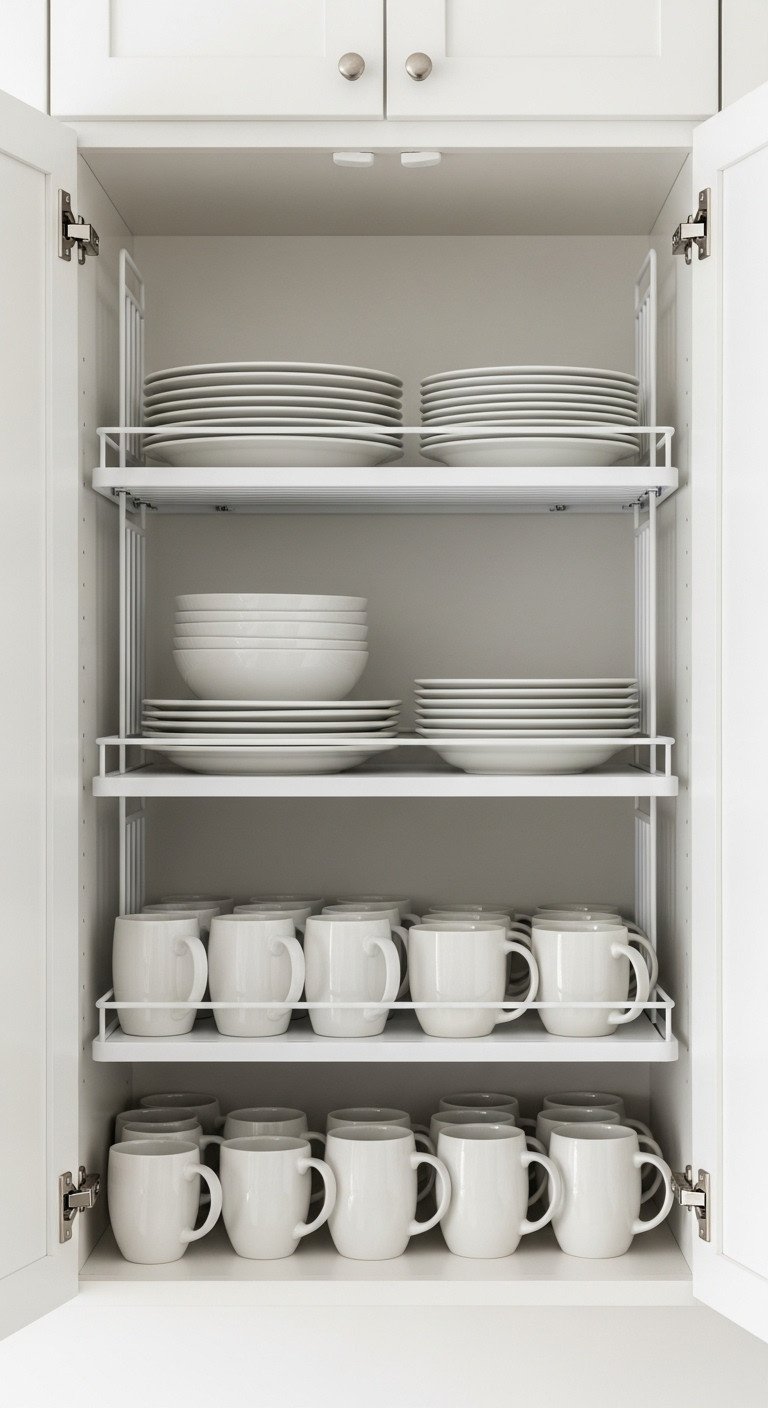
Double your cabinet space! Pin this idea now.
Tall kitchen cabinets often become “black holes” where items get lost in the back. You can instantly double your usable storage space by adding expandable shelf organizers. These simple metal racks create a second level within a single shelf, allowing you to stack items without creating unstable, teetering towers.
- Materials Needed: 1-2 expandable cabinet shelf organizers.
- Step-by-Step Directions:
- Empty the cabinet you want to organize and give it a good wipe-down.
- Measure the interior width of the cabinet.
- Adjust an expandable shelf organizer to fit the width of your space. These clever racks instantly create a second level of storage.
- Place taller or less-frequently used items at the back, and place the shelf over them.
- Stack everyday items like plates or bowls on top of the shelf, and slide shorter items like mugs or small bowls underneath. This use of vertical space can double your storage capacity.
Lesson Learned: For under-sink cabinets, look for U-shaped or adjustable organizers designed to fit around pipes, maximizing that awkward space.
6. Utilize Awkward Gaps with Slim Storage
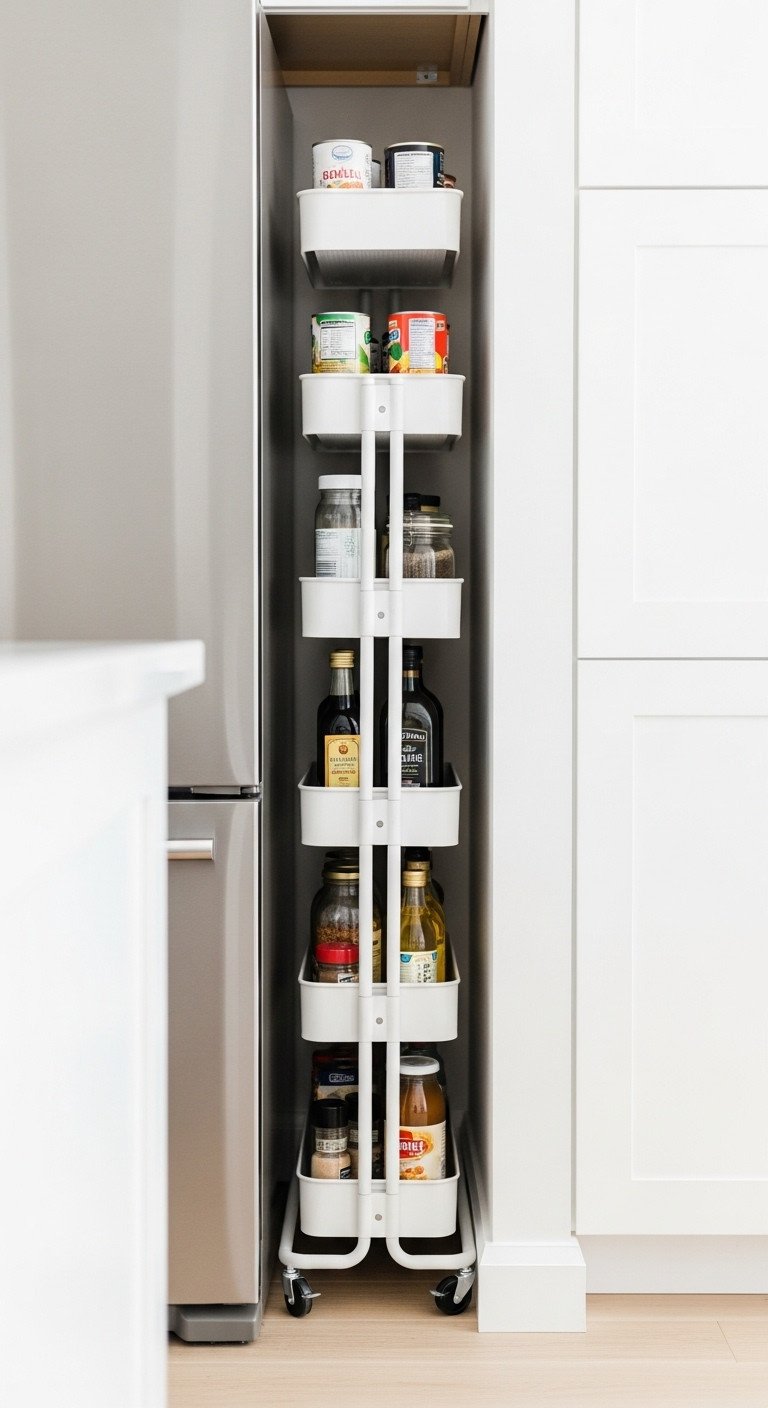
Turn wasted space into storage! You have to pin this.
Those strange, narrow gaps next to the refrigerator or stove are no longer wasted space. You can transform these awkward spots into a hidden pantry with a slim, rolling storage cart. This is a hallmark of Japanese organization—finding a purpose for every single inch of the kitchen.
- Materials Needed: 1x slim rolling storage cart.
- Step-by-Step Directions:
- Identify and measure any narrow gaps in your kitchen, such as between the refrigerator and the wall, or next to the stove. Some carts are designed for spaces as small as 4-5 inches wide.
- Purchase a slim rolling cart that fits your measurements. Brands like Yamazaki specialize in these stylish, narrow designs.
- Assemble the cart; most are simple to put together and come with smooth-gliding wheels.
- Load the shelves with pantry staples, spices, cleaning supplies, or other items that don’t have a designated home.
- Slide the cart into the gap. Now, instead of wasted space, you have a convenient, hidden pantry on wheels.
Pro-Tip: Look for a cart with a small handle or a raised edge on the top shelf. This makes it easier to pull out and prevents items from toppling over as it moves.
7. Bring Calm with Uniform, Organized Containers
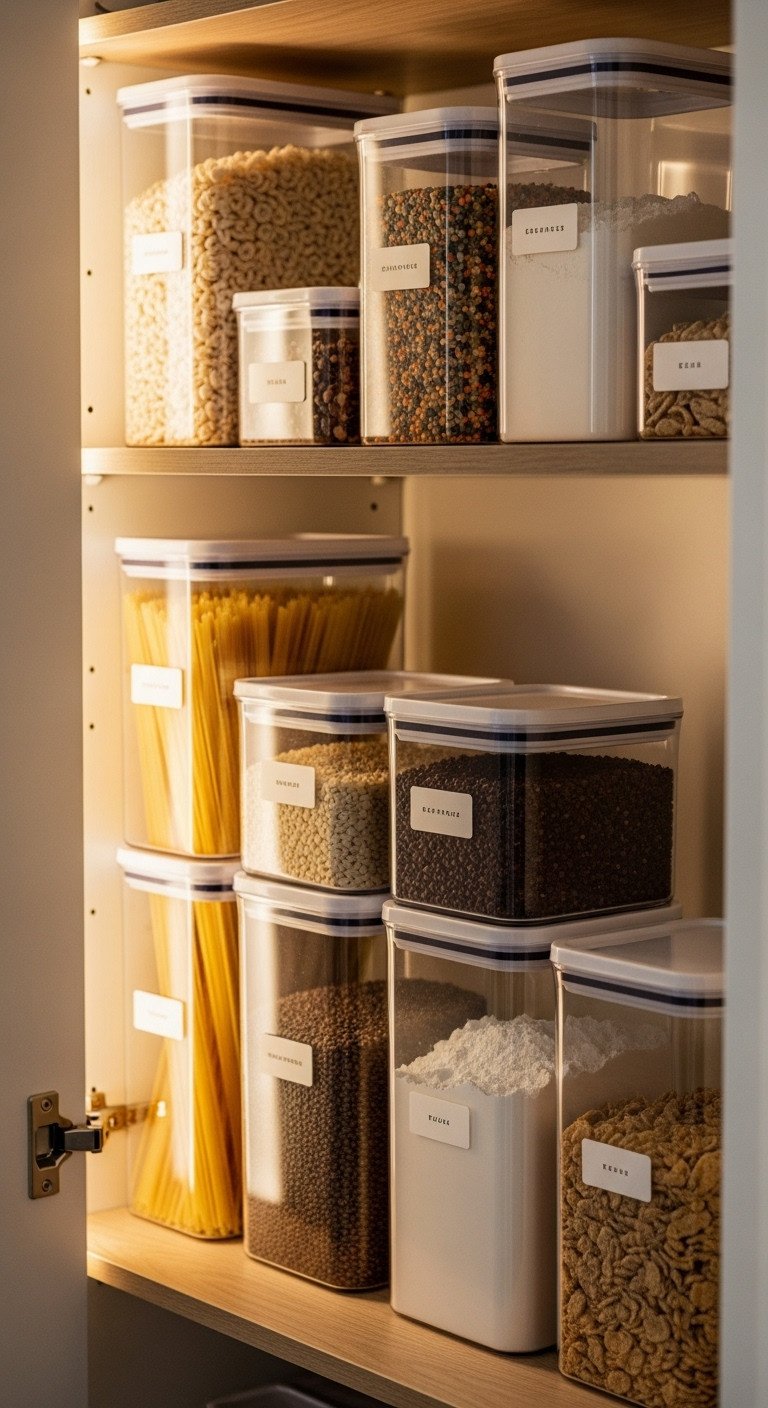
This is so satisfying! Pin this pantry inspiration.
Visual clutter contributes heavily to the feeling of chaos. You can create instant visual calm by decanting your dry goods into a set of uniform, clear, and stackable containers. This eliminates the visual noise of mismatched packaging and creates a pantry that is as beautiful as it is functional.
- Materials Needed: A set of uniform, clear, stackable, airtight food storage containers; labels and a marker.
- Step-by-Step Directions:
- Decant your dry goods (flour, sugar, pasta, cereal, snacks) from their original packaging into the containers.
- Using clear containers allows you to see exactly what you have and how much is left at a glance, preventing over-buying.
- Label each container clearly. This is essential for telling apart similar-looking items like baking soda and baking powder.
- Arrange the containers on your shelves. Because they are uniform and stackable, they will take up less space and create a clean, minimalist aesthetic.
Lesson Learned: Before you decant a new bag of flour or sugar, clip the expiration date from the original packaging and tape it to the bottom of the container.
8. Install Pull-Out Drawers in Deep Cabinets
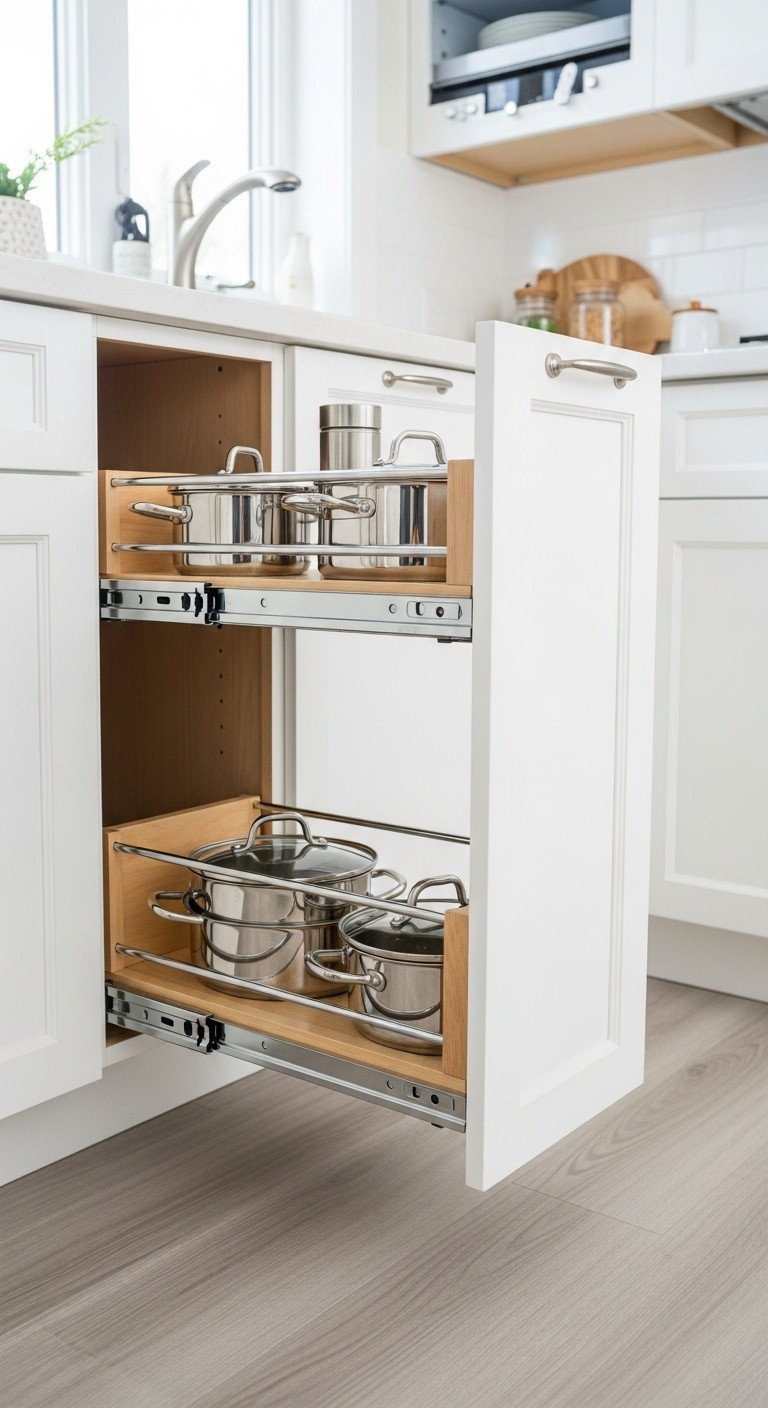
No more digging in cabinets! Pin this smart solution.
Deep base cabinets are notoriously difficult to keep organized. Stop kneeling and blindly reaching into the dark by installing pull-out cabinet organizers that bring the contents of your cabinet to you. This simple upgrade makes every item perfectly accessible, especially heavy pots, pans, and small appliances.
- Materials Needed: A pull-out cabinet organizer kit, drill, measuring tape.
- Step-by-Step Directions:
- Measure the interior dimensions of your base cabinet (width, depth, and height) to ensure you purchase the correct size organizer.
- Choose an organizer that suits your needs. There are single-tier options for large appliances and two-tier versions for pots, pans, and smaller items.
- Follow the manufacturer’s instructions to install the sliding base into the bottom of your cabinet. Most kits install with just a few screws.
- Once the track is secure, click the drawer or basket into place.
- Organize your heavy pots, pans, or small appliances in the drawer. Now you can effortlessly slide everything out to you instead of kneeling and digging through the back of the cabinet.
Pro-Tip: Invest in a model with soft-close slides. It’s a small luxury that prevents slamming and keeps your items from shifting around every time you close the drawer.
9. Organize with Labeled Baskets and Bins
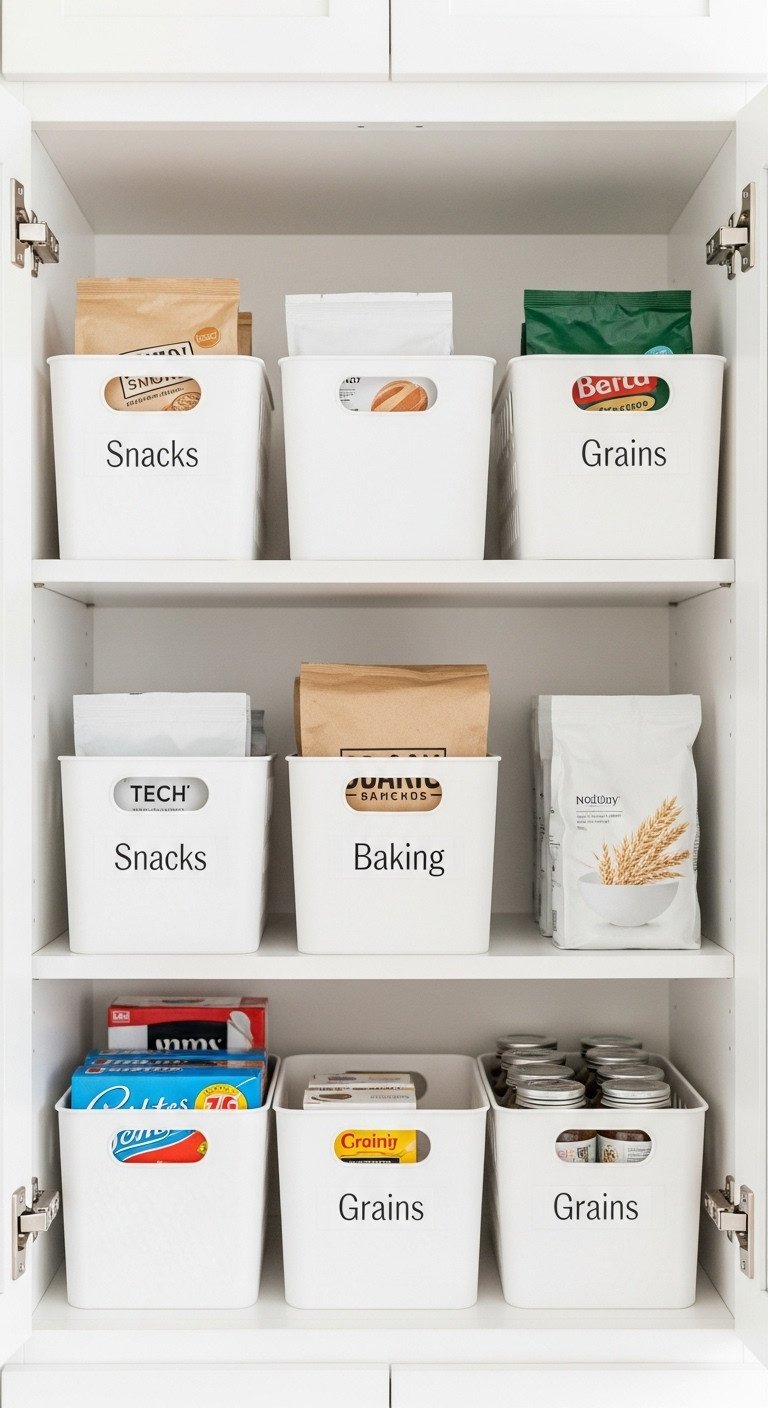
Category organization is a game-changer. Save this idea!
To prevent pantries and cupboards from becoming a jumbled mess, group similar items together in designated, labeled bins or baskets. This “zone” method makes it incredibly easy to find what you need and, just as importantly, to put things away in their proper home.
- Materials Needed: A set of matching plastic bins or baskets, labels or a label maker.
- Step-by-Step Directions:
- Take everything out of your pantry or a cluttered cabinet.
- Group like items together: all the baking supplies, all the pasta and grains, all the kids’ snacks, etc.
- Place each category into its own designated bin or basket. Using uniform containers creates a clean, cohesive look.
- Create clear, easy-to-read labels for each bin. This is the most important step for long-term maintenance.
- Place the bins back on the shelves. Now, instead of rummaging for a specific item, you can just pull out the entire relevant basket.
Lesson Learned: Use clear or semi-porous baskets for items you want to be able to see at a glance, and solid-colored baskets for items you’d prefer to keep hidden for a cleaner look.
10. Employ Versatile Tension Rods for Instant Storage
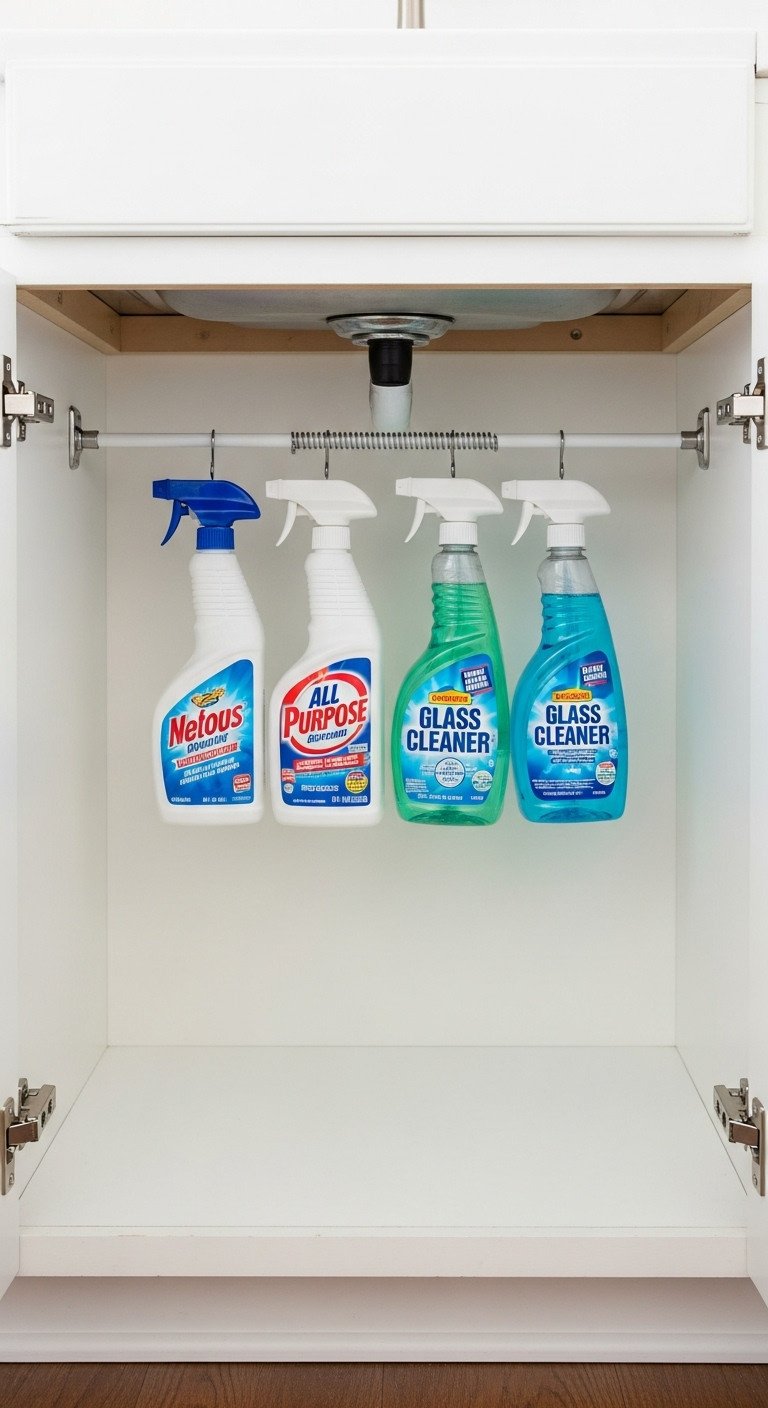
So clever and simple! Pin this hack right now.
The humble tension rod is an organization superstar. This inexpensive tool can be used to create instant, damage-free hanging storage or dividers in almost any small space. Its versatility is unmatched, especially for awkward areas like the cabinet under the sink.
- Materials Needed: 1x small, adjustable spring tension rod.
- Step-by-Step Directions:
- Measure the width of the space where you want to add storage, such as high up in the cabinet under your sink.
- Purchase a tension rod that adjusts to that width. Mini tension rods are perfect for cabinets.
- Install the tension rod by twisting it to extend until it fits snugly between the two surfaces. No tools or drilling required.
- Hang your spray bottles from the rod by their triggers. This lifts them off the cabinet floor, freeing up space below for other items like sponges and bins.
Pro-Tip: Use a tension rod vertically in a deep drawer to create a divider for pot lids or baking sheets, keeping them upright and easy to grab.
11. Prioritize Stackable Cookware and Uniform Containers
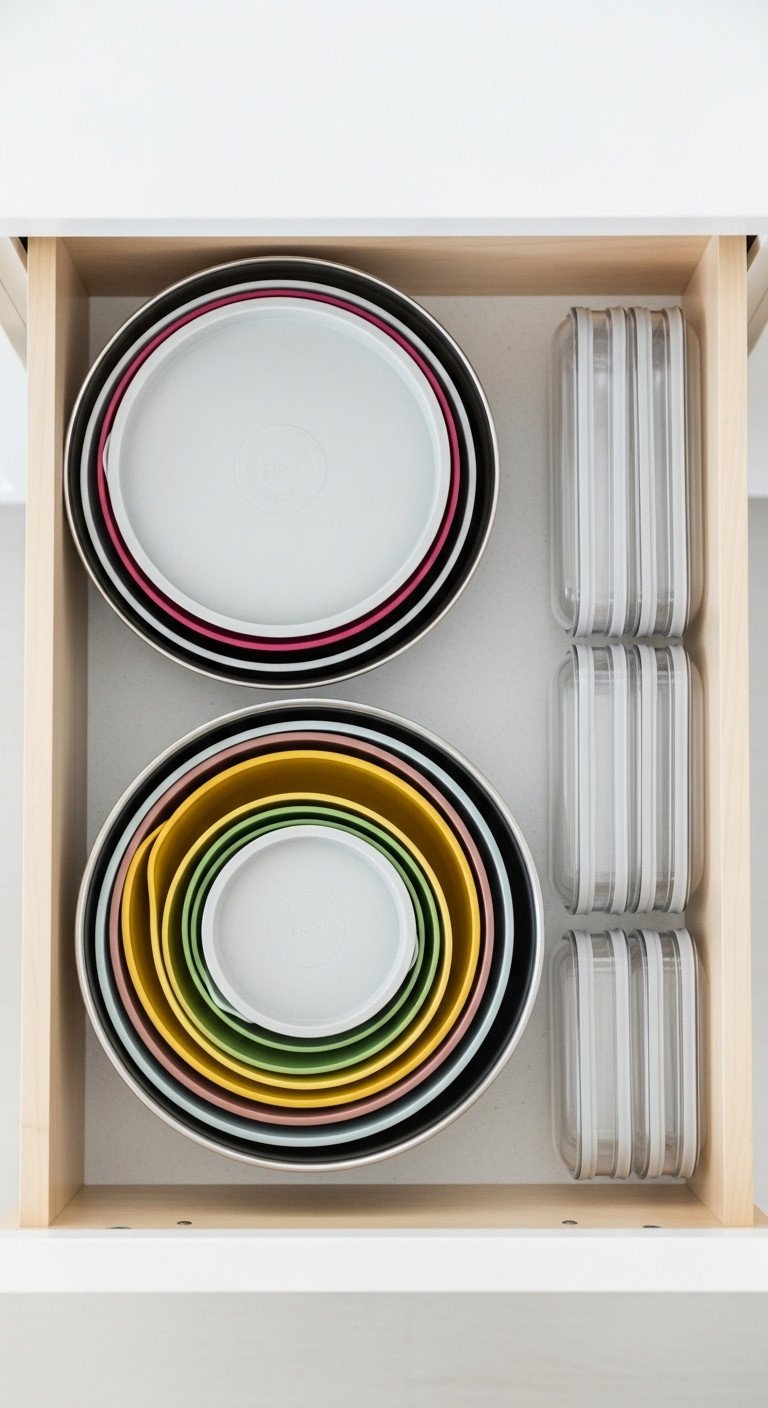
Nesting cookware is a must-have for small kitchens. Pin it!
A fundamental principle for saving space is to choose items that are specifically designed to be stackable or nesting. A random assortment of bowls and containers with different shapes and sizes wastes an incredible amount of cabinet real estate.
- Materials Needed: A set of nesting mixing bowls with lids.
- Step-by-Step Directions:
- Audit your current collection of mixing bowls, food containers, and pots. A “hodgepodge” of mismatched items wastes significant space.
- Invest in sets that are specifically designed to be “nesting” or “stackable.” For example, a set of five mixing bowls with lids should nest together to take up the footprint of only the largest bowl.
- When storing, always place the smallest item inside the next largest, and so on.
- This principle applies to everything from measuring cups and spoons to pots and food storage containers, dramatically reducing the amount of cabinet and drawer space required.
Lesson Learned: Before you buy a new set of food containers, check to see if the lids are also designed to stack or snap together. Lost lids are a major source of kitchen clutter!
Key Takeaways: Your Quick Guide to Japanese Kitchen Organization
To quickly review, transforming your kitchen is about adopting a new mindset and using a few clever tools. The most important principles to remember are:
- Embrace Vertical Space: Use walls, cabinet doors, and the sides of appliances for storage.
- Utilize Every Gap: Slim rolling carts and narrow organizers turn wasted space into a functional pantry.
- Divide and Conquer: Use internal organizers like shelves and tension rods to make cabinets more efficient.
- Create Visual Calm: Opt for uniform, stackable containers and baskets to reduce visual clutter.
- Choose Multi-Functional Items: An over-the-sink dish rack not only dries dishes but can also store them.
People Also Ask About Japanese Kitchen Organization
How can I make my small kitchen look more minimalist and Japanese-inspired?
The key to a minimalist look is to start by minimizing visual clutter. Keep your countertops as clear as possible by giving every item a home using the storage hacks above. Choose storage containers and organizers in a cohesive, neutral color palette like white, wood tones, and black. Decant pantry items from their chaotic packaging into uniform jars and hide anything else in simple baskets. The focus should always be on natural materials, clean lines, and simplicity.
What is the Yamazaki brand and why is it popular for kitchen organization?
Yamazaki is a popular Japanese home goods brand renowned for its brilliant fusion of beautiful form and intelligent function. Their products embody the minimalist aesthetic, focusing on high-quality materials like steel and wood. They excel at providing clever, space-saving solutions for common household organization problems, making their entire product line perfectly suited for small kitchens where every inch counts.
What is the first step in decluttering my kitchen the Japanese way?
The crucial first step is to empty one small area completely, such as a single drawer or one shelf in a cabinet. Handle each and every item and ask yourself if you truly need and use it, following the “Danshari” principle of intentionally letting go of excess. You must discard or donate anything that doesn’t serve a real purpose in your kitchen before you even begin to think about organizing what’s left.
Are tension rods strong enough to hold things in a kitchen?
Yes, when used correctly for the right task, tension rods are surprisingly strong and reliable. For tasks like hanging multiple spray bottles by their triggers or creating vertical dividers for lightweight pot lids and baking sheets, a small, spring-loaded tension rod provides more than enough support. They are an excellent, damage-free way to add instant organization inside cabinets and drawers.
Final Thoughts
Organizing a small kitchen isn’t about wishing you had more space; it’s about making the most of the space you already have with intention and ingenuity. By embracing the Japanese philosophy of functionality and minimalism, you can create a kitchen that not only looks beautiful and feels larger but also makes your daily routine simpler and more enjoyable. It’s about transforming your relationship with your space from one of frustration to one of peace and efficiency.
Now it’s your turn. Which of these Japanese organization hacks are you most excited to try first in your own kitchen? Share your thoughts and plans in the comments below
Last update on 2025-10-15 at 00:00 / Affiliate links / Images from Amazon Product Advertising API
